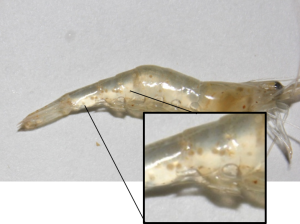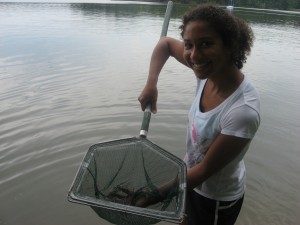By Katie Sinclair
While the idea of playing host to something out of the movie Alien is decidedly unpleasant, it’s hard not to marvel at the exquisite grossness of microscopic parasites. Parasites take advantage of their hosts for resources and shelter, but research on parasites suggests that they also can manipulate their hosts’ behavior: Crickets will drown themselves, snails position themselves to be eaten by birds, and some theories suggest that cat-lovers infected with the parasite Toxoplasma gondii become self-destructively reckless. More than half the known species in the world are parasites—making parasitism the most popular lifestyle on Earth.
At the Smithsonian Environmental Research Center (SERC), the Marine Invasions Lab has been tracking parasites in grass shrimp, an incredibly common near shore species. Rates of parasitism are extremely high in grass shrimp, with some years 90 percent of the shrimp caught displaying parasite infection. The most common parasite is a trematode that forms cysts in the tail of the shrimp. Sara Gonzalez, who interned with SERC this summer, wanted to see if parasitized shrimp displayed different predator avoidance behaviors than unparasitized shrimp. Because the trematode only reproduces in birds and mammals, the parasite must find a way to make its way up the food chain. Sara suspected that infected shrimp will change their behavior in a way that makes them more vulnerable to predators like mummichogs. The parasite does not infect the mummichogs directly, but mummichogs are prey for mammals and birds. If a mummichog that has ingested an infected shrimp gets eaten by a bird or mammal, then the parasite will be able to reproduce.
Sara first looked at the use of woody debris by infected and uninfected shrimp. Studies have shown that grass shrimp use woody debris as a way to avoid predators. Sara used sweep nets to collect parasitized and unparasitized shrimp, and then set up a tethering experiment (shrimp fastened with fishing line to stakes to see how many survive) with two treatments: one with shrimp tethered on bare sediment, and one with shrimp on woody debris. The shrimp were placed far enough away to not interact with each other, with alternating placements of parasitized and unparasitized shrimp. In the woody debris trial, Sara suspected that parasitized shrimp would have a shorter survival time, since the parasite would affect their use of woody debris to avoid predation.
However, the results of the tethering trial were inconclusive: All the shrimp were eaten, and there were no significantdifferences between survival times between woody debris and bare sediment trials, or between parasitized and unparasitized shrimp. Undeterred, Sara went back to the lab to set up an experiment to monitor the shrimp’s behavior. She set up four treatments and ran each trial for parasitized and unparasitized shrimp: tanks with a shrimp and no mummichogs, shrimp with a mummichog, shrimp with woody debris, and shrimp with woody debris and mummichogs. Sara rigged a camera to record the trials in order to not disturb the animals.
After reviewing the footage, Sara did find that parasitized and unparasitized shrimp behaved differently. Both parasitized and unparasitized shrimp used woody debris more in the presence of mummichogs than when there were no mummichogs, but there was a difference in the parasitized and unparasitized swimming behavior. Unparasitized shrimps tended to go still and stop swimming in the presence of predators, a known predator avoidance technique. Parasitized shrimp, however, swam just as much in the presence of a predator than with no predator. Swimming in the presence of a predator could make the shrimp easier to detect. Sara also found that unparasitized shrimp did more “backthrusts” (a shrimp’s version of an evasive maneuver) than unparasitized shrimp.
While it is still unknown exactly how the trematodes were able to influence shrimp behavior, Sara did find that unparasitized and parasitized shrimp displayed different predator avoidance behaviors. Both parasitized and unparasitized shrimp hid under woody debris in the presence of a predator, but the differences in swimming behavior suggests that parasitized shrimp are more likely to be eaten. While inch-long shrimp infected with millimeter-long parasites may seem small in comparison with the ecosystem as a whole, parasites are some of the most abundant organisms in the world and can impact hosts’ health and behavior. Sara’s shrimp behavior experiment is adding to the body of research of parasites—an often overlooked group that may be one of the most powerful on the planet.



